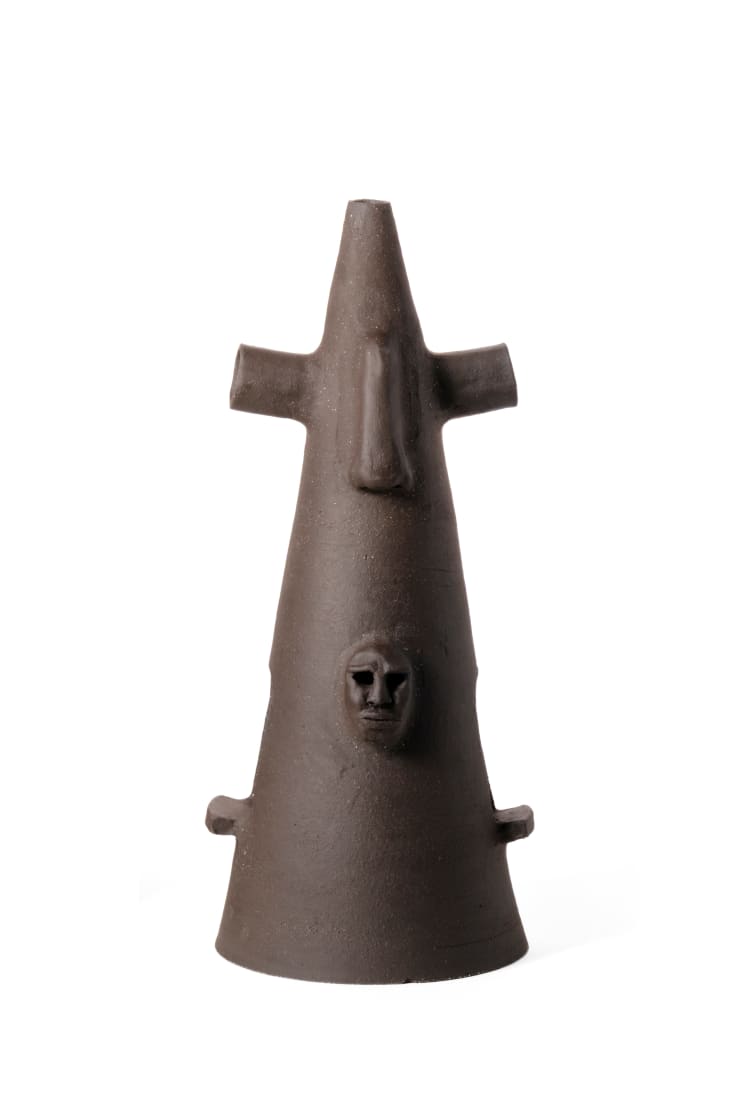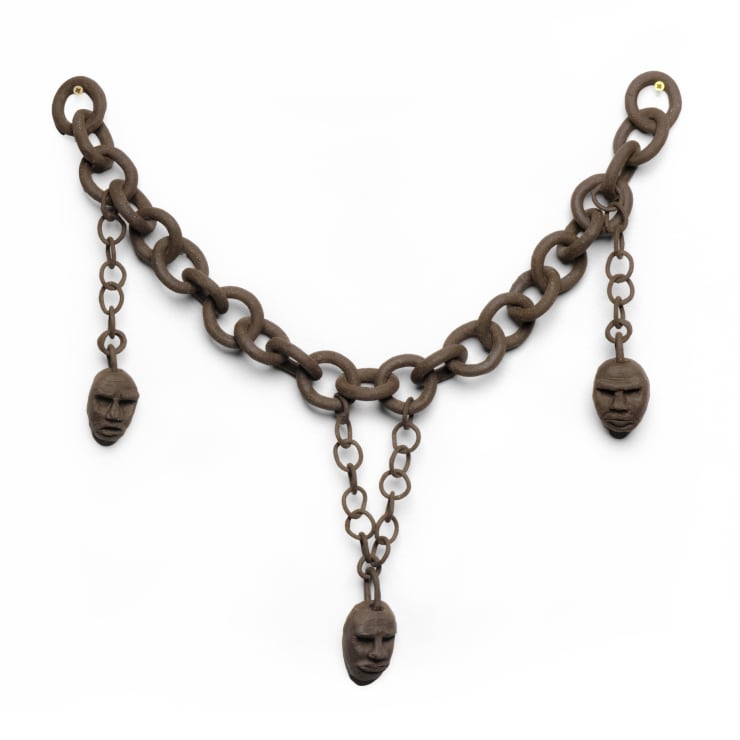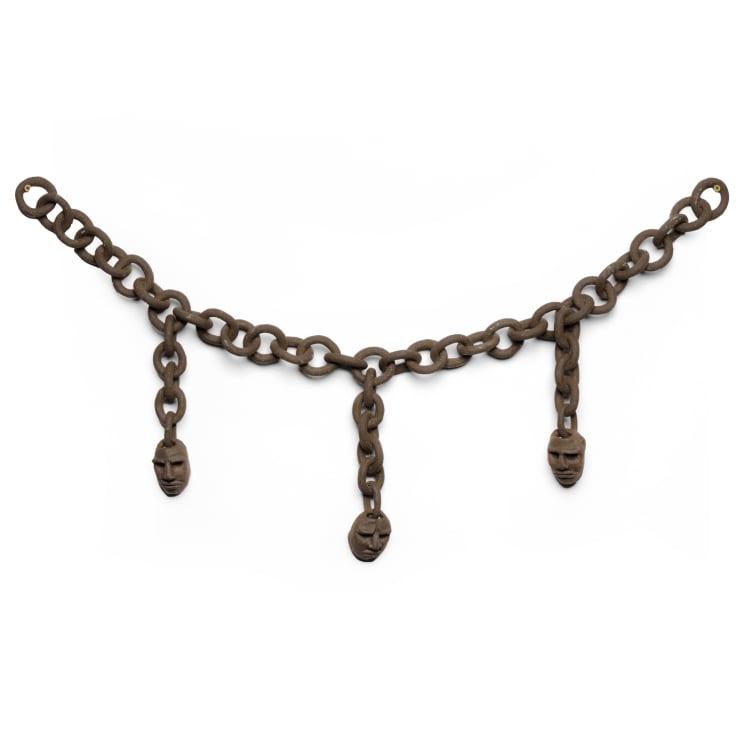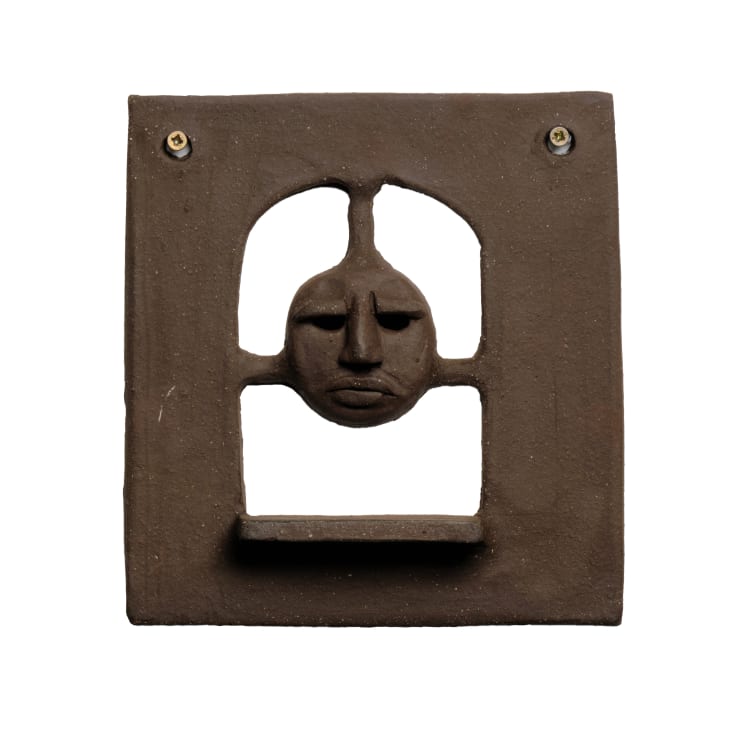Tahlia Undarlegt: Same Today as Yesterday Hopefully Not Tomorrow
At the heart of Tahlia Undarlegt's practice lies an ancient pulse - the steady,
grounding rhythm of clay as it yields to the hand. Her exhibition Same Today as Yesterday, Hopefully Not Tomorrow gathers a collection of sculptural figures
and ceramic chains that appear both primordial and futuristic, as though unearthed from an archaeological site belonging to a civilisation not yet known. These works seem to emerge from a deep collective memory, evoking a time when humanity existed as one undivided species, before language splintered and difference was named.
Undarlegt's exploration of connection - to self, ancestry, and the wider human story - began with her grandmother's experience as part of the Stolen Generations. In retracing that story and reconnecting with language groups in Western Australia, the artist uncovered a thread of belonging that led her to consider what binds all humans together. Beneath cultural, historical, and psychological separation, she sensed a deep undercurrent of shared humanity.
Clay, in Undarlegt's hands, is more than material; it is memory. It recalls the first gestures of art and record - handprints on cave walls, vessels for water, tablets for script. "The handprint is the perfect work," she says. "It transcends culturally, globally, and brings us back to the first conscious thought of creativity." Her surfaces hum with the residue of countless hands, each fingerprint reaching both backward and forward through time.
Her recurring motif of the chain deepens this meditation on connection and fragility. Traditionally a symbol of bondage or control, the chain here becomes an emblem of strength and empathy - delicate yet heavy, fragile yet enduring. "It's always seen as this dark heavy element," she notes, "but really it's about fragility and connection."
Language threads quietly through the exhibition, intertwining English and Cundeelee Wangka words such as Wati (man), Tjuma (story), and Kaparli (grandmother). These titles acknowledge the artist's process of reconnection while widening the field of human resonance.
Through her sculptures, Undarlegt channels both the sacred and the everyday. Her works do not present answers; they create a space to remember our shared origins and to imagine futures not yet written. They remind us that connection is not an abstract ideal, but a truth embedded in the clay of our being - a quiet call to recognise one another once again as one people.
-
 Tahlia Undarlegt1992 ~ PresentMoorditj, 2025Signed and datedMid-fire ceramic with underglaze111 × 32 × 32 cmAU$ 1,880.00
Tahlia Undarlegt1992 ~ PresentMoorditj, 2025Signed and datedMid-fire ceramic with underglaze111 × 32 × 32 cmAU$ 1,880.00 -
 Tahlia Undarlegt1992 ~ PresentTjuma, 2025Signed and datedMid-fire ceramic with underglaze78 × 30 × 26 cmAU$ 1,720.00
Tahlia Undarlegt1992 ~ PresentTjuma, 2025Signed and datedMid-fire ceramic with underglaze78 × 30 × 26 cmAU$ 1,720.00 -
 Tahlia Undarlegt1992 ~ PresentTjuma II, 2025Signed and datedMid-fire ceramic with underglaze76 × 29 × 26 cmAU$ 1,680.00
Tahlia Undarlegt1992 ~ PresentTjuma II, 2025Signed and datedMid-fire ceramic with underglaze76 × 29 × 26 cmAU$ 1,680.00 -
 Tahlia Undarlegt1992 ~ PresentKaparli, 2025Signed and datedMid-fire ceramic65 × 36 × 25.5 cmAU$ 1,540.00
Tahlia Undarlegt1992 ~ PresentKaparli, 2025Signed and datedMid-fire ceramic65 × 36 × 25.5 cmAU$ 1,540.00 -
 Tahlia Undarlegt1992 ~ PresentMoorditj II, 2025Signed and datedMid-fire ceramic with underglaze39 × 21 × 21 cmAU$ 1,140.00
Tahlia Undarlegt1992 ~ PresentMoorditj II, 2025Signed and datedMid-fire ceramic with underglaze39 × 21 × 21 cmAU$ 1,140.00 -
 Tahlia Undarlegt1992 ~ PresentMoorditj III, 2025Signed and datedMid-fire ceramic with underglaze38 × 22 × 21 cmAU$ 1,140.00
Tahlia Undarlegt1992 ~ PresentMoorditj III, 2025Signed and datedMid-fire ceramic with underglaze38 × 22 × 21 cmAU$ 1,140.00 -
 Tahlia Undarlegt1992 ~ PresentThe Stranger on the Left, 2025Signed and datedMid-fire ceramic65 × 36 × 25.5 cmAU$ 1,180.00
Tahlia Undarlegt1992 ~ PresentThe Stranger on the Left, 2025Signed and datedMid-fire ceramic65 × 36 × 25.5 cmAU$ 1,180.00 -
 Tahlia Undarlegt1992 ~ PresentThe Stranger on the Right, 2025Signed and datedMid-fire ceramic50 × 21 × 20 cmAU$ 1,260.00
Tahlia Undarlegt1992 ~ PresentThe Stranger on the Right, 2025Signed and datedMid-fire ceramic50 × 21 × 20 cmAU$ 1,260.00 -
 Tahlia Undarlegt1992 ~ PresentWhat Divides Us, 2025Signed and datedMid-fire ceramic44.5 × 20 × 24 cmAU$ 1,220.00
Tahlia Undarlegt1992 ~ PresentWhat Divides Us, 2025Signed and datedMid-fire ceramic44.5 × 20 × 24 cmAU$ 1,220.00 -
 Tahlia Undarlegt1992 ~ PresentWhat Holds Us Together, 2025Signed and datedMid-fire ceramic40.5 × 20 × 24 cmAU$ 1,180.00
Tahlia Undarlegt1992 ~ PresentWhat Holds Us Together, 2025Signed and datedMid-fire ceramic40.5 × 20 × 24 cmAU$ 1,180.00 -
 Tahlia Undarlegt1992 ~ PresentWati, 2025Signed and datedMid-fire ceramic35 × 29 × 15 cmAU$ 720.00
Tahlia Undarlegt1992 ~ PresentWati, 2025Signed and datedMid-fire ceramic35 × 29 × 15 cmAU$ 720.00 -
 Tahlia Undarlegt1992 ~ PresentIn the End Only Kindness Matters, 2025Signed and datedYarn on monk cloth110 × 109 × 1 cmSold
Tahlia Undarlegt1992 ~ PresentIn the End Only Kindness Matters, 2025Signed and datedYarn on monk cloth110 × 109 × 1 cmSold -
 Tahlia Undarlegt1992 ~ PresentHate Will Break Us Down, 2025Signed and datedMid-fire ceramic45 × 55 × 7 cmAU$ 1,080.00
Tahlia Undarlegt1992 ~ PresentHate Will Break Us Down, 2025Signed and datedMid-fire ceramic45 × 55 × 7 cmAU$ 1,080.00 -
 Tahlia Undarlegt1992 ~ PresentDon’t Trade Away Your Soul , 2025Signed and datedMid-fire ceramic80 × 41 × 6 cmAU$ 1,240.00
Tahlia Undarlegt1992 ~ PresentDon’t Trade Away Your Soul , 2025Signed and datedMid-fire ceramic80 × 41 × 6 cmAU$ 1,240.00 -
 Tahlia Undarlegt1992 ~ PresentWe All Bleed the Same, 2025Signed and datedMid-fire ceramic80 × 50 × 6 cmAU$ 1,240.00
Tahlia Undarlegt1992 ~ PresentWe All Bleed the Same, 2025Signed and datedMid-fire ceramic80 × 50 × 6 cmAU$ 1,240.00 -
 Tahlia Undarlegt1992 ~ PresentWe’ve All Become Strangers, 2025Signed and datedMid-fire ceramic80 × 47 × 6 cmAU$ 1,240.00
Tahlia Undarlegt1992 ~ PresentWe’ve All Become Strangers, 2025Signed and datedMid-fire ceramic80 × 47 × 6 cmAU$ 1,240.00 -
 Tahlia Undarlegt1992 ~ PresentChain I, 2025Signed and datedMid-fire ceramic180 × 5 × 5 cmAU$ 1,280.00
Tahlia Undarlegt1992 ~ PresentChain I, 2025Signed and datedMid-fire ceramic180 × 5 × 5 cmAU$ 1,280.00 -
 Tahlia Undarlegt1992 ~ PresentChain II, 2025Signed and datedMid-fire ceramic180 × 5 × 5 cmAU$ 1,280.00
Tahlia Undarlegt1992 ~ PresentChain II, 2025Signed and datedMid-fire ceramic180 × 5 × 5 cmAU$ 1,280.00 -
 Tahlia Undarlegt1992 ~ PresentIt's Everybody, 2025Signed and datedMid-fire ceramic21 × 19 × 4 cmSold
Tahlia Undarlegt1992 ~ PresentIt's Everybody, 2025Signed and datedMid-fire ceramic21 × 19 × 4 cmSold -
 Tahlia Undarlegt1992 ~ PresentIt’s Not Just Me, 2025Signed and datedMid-fire ceramic23 × 21 × 3.5 cmAU$ 540.00
Tahlia Undarlegt1992 ~ PresentIt’s Not Just Me, 2025Signed and datedMid-fire ceramic23 × 21 × 3.5 cmAU$ 540.00 -
 Tahlia Undarlegt1992 ~ PresentIt’s Not Just You, 2025Signed and datedMid-fire ceramic22.5 × 18.5 × 3.5 cmAU$ 520.00
Tahlia Undarlegt1992 ~ PresentIt’s Not Just You, 2025Signed and datedMid-fire ceramic22.5 × 18.5 × 3.5 cmAU$ 520.00






















